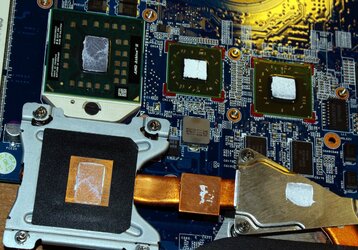I've been given a HP G62 to fix in a real hurry. It needs a system reinstall, but it keeps shutting down due to overheating before I can manage to install Windows. It's always had heat issues and I recommended using one of those fanned stands; that helped for a while, but the problems got worse and now it's basically unusable.
I took it apart and removed the expected plug of compacted dust from the heatsink's fins, but the thick-ish thermal pads on the heatsink crumbled and fell apart. I replaced them with some decent-quality goop, but it turns out the heatsink doesn't press much on the GPU and doesn't press at all on what I assume is the northbridge. Whoever designed this relied on the thermal pads to do most of the heat transfer instead of actual physical contact. Here's a picture of what I saw after I applied the goop, installed the heatsink, screwed it down tight, then removed it to check:
Under normal circumstances I'd consider getting more pad stuff to put in there, but:
1) I feel relying on the pads to do the heat transfer is retarded and would like to do a better job fixing it than HP did making it, and
2) this is a very urgent job. The laptop needs to be ready yesterday, but a) tomorrow is sunday and all the shops are closed, b) even if they weren't I currently live in a tiny town and the best-stocked computer store in a range of about a million miles doesn't even know what anything beyond plain thermal goop is (I tried, believe me), and c) this country has the postal system of a third-world backwater, so any online order would take way too long to get here.
In other words, I have to fix it with what I have around.
The space to fill up isn't very large (I'm more worried about the GPU that kinda-sorta already brushes against the heatsink than about the northbridge which simply needs to touch something that isn't just air), so I'm thinking perhaps a small square of aluminium foil or two with a superthin layer of heatsink goop in between. I'm aware copper would be better, but I don't know where to get a plate of sufficiently narrow thickness.
What do you think? Any ideas?
I took it apart and removed the expected plug of compacted dust from the heatsink's fins, but the thick-ish thermal pads on the heatsink crumbled and fell apart. I replaced them with some decent-quality goop, but it turns out the heatsink doesn't press much on the GPU and doesn't press at all on what I assume is the northbridge. Whoever designed this relied on the thermal pads to do most of the heat transfer instead of actual physical contact. Here's a picture of what I saw after I applied the goop, installed the heatsink, screwed it down tight, then removed it to check:
Under normal circumstances I'd consider getting more pad stuff to put in there, but:
1) I feel relying on the pads to do the heat transfer is retarded and would like to do a better job fixing it than HP did making it, and
2) this is a very urgent job. The laptop needs to be ready yesterday, but a) tomorrow is sunday and all the shops are closed, b) even if they weren't I currently live in a tiny town and the best-stocked computer store in a range of about a million miles doesn't even know what anything beyond plain thermal goop is (I tried, believe me), and c) this country has the postal system of a third-world backwater, so any online order would take way too long to get here.
In other words, I have to fix it with what I have around.
The space to fill up isn't very large (I'm more worried about the GPU that kinda-sorta already brushes against the heatsink than about the northbridge which simply needs to touch something that isn't just air), so I'm thinking perhaps a small square of aluminium foil or two with a superthin layer of heatsink goop in between. I'm aware copper would be better, but I don't know where to get a plate of sufficiently narrow thickness.
What do you think? Any ideas?

